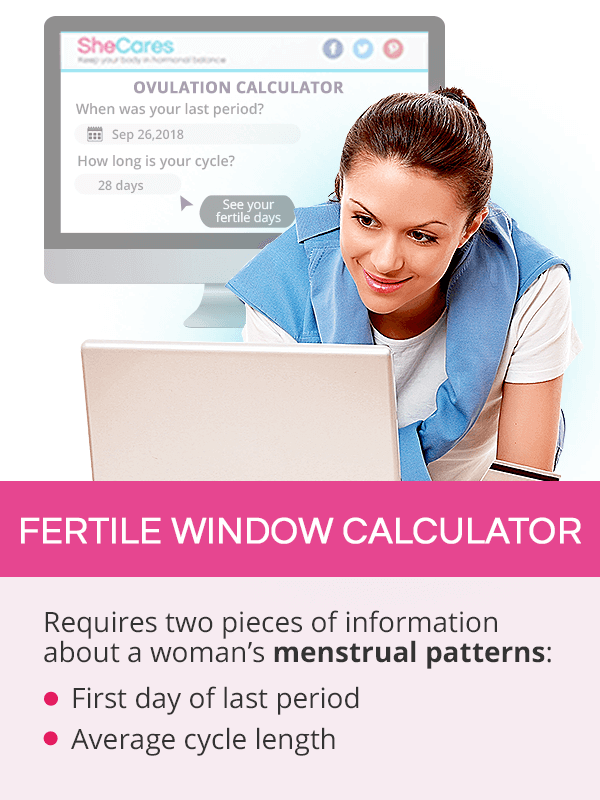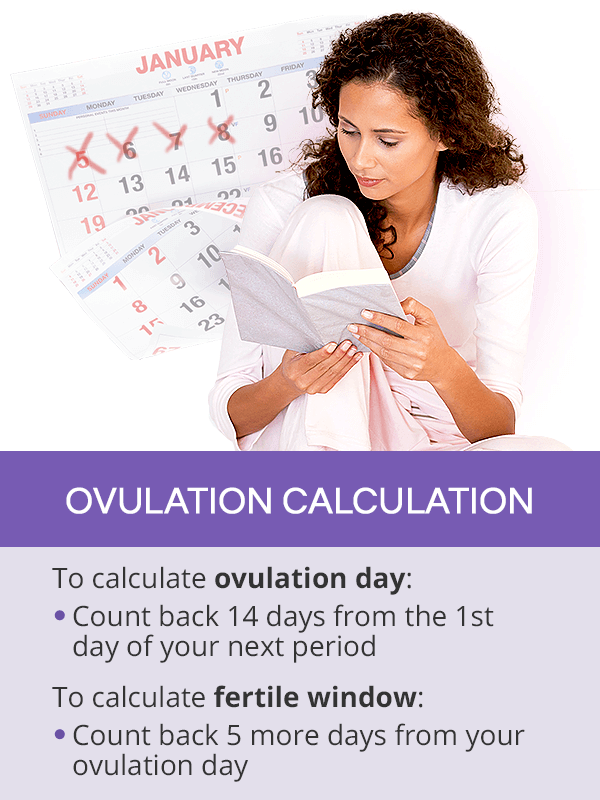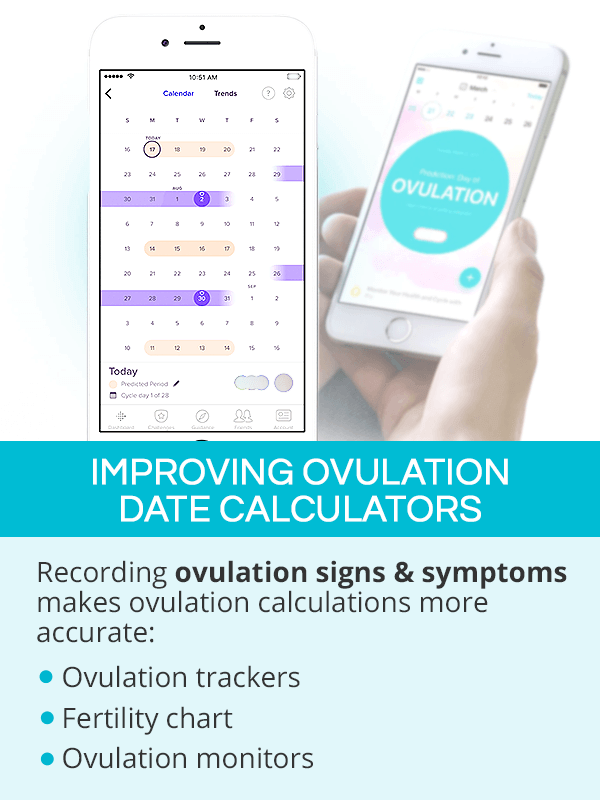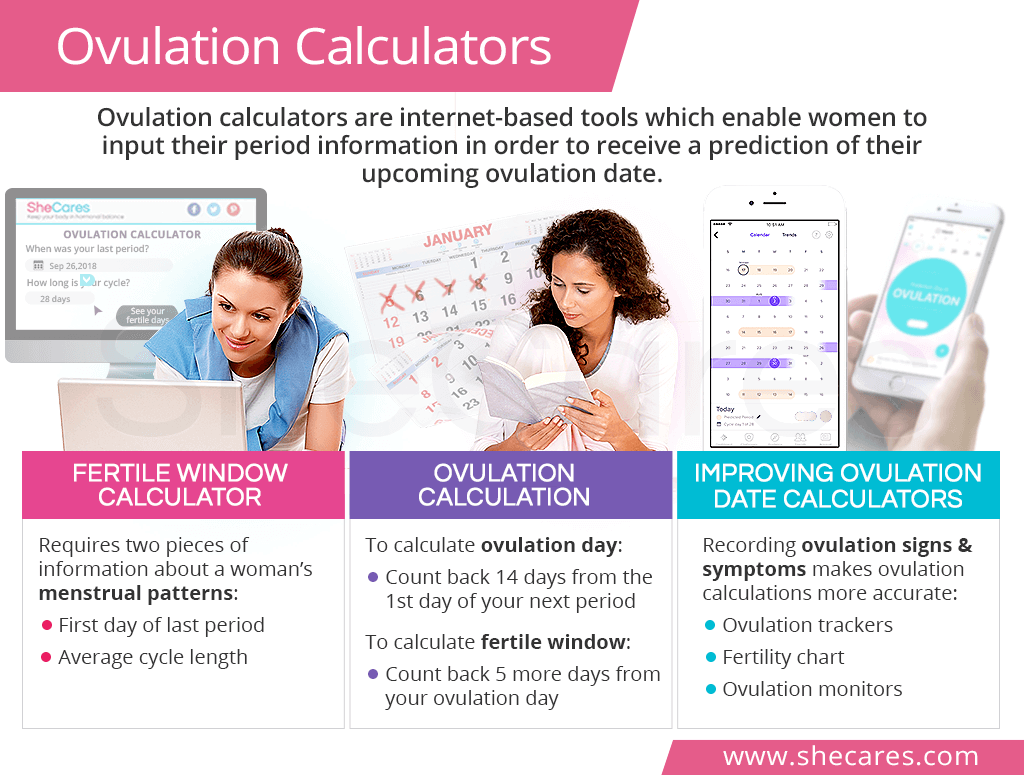Ovulation Calculator
What is an Ovulation Calculator?

An ovulation calculator, also known as a fertility calculator, is an internet-based tool that is used to quickly estimate the next period, ovulation day, and fertile window in a given cycle.
A wide variety of free ovulation calculators is available online on numerous websites dedicated to female sexual health.
Using an ovulation calendar is not only beneficial to women preparing to get pregnant, but also those whose goal is to prevent or delay pregnancy naturally.
How are Ovulation Calculations Done?

To estimate when ovulation is most likely to occur, a woman needs to have the following information about her menstruation ready:
First day of the last period
Average length of menstrual cycle
For clarity, a cycle begins on the first day of a period and lasts until the first day of next month's bleeding.
If a woman is unsure about the patterns of her menstruation, she can maintain an ovulation calendar for at least three months to improve the accuracy of her predictions.
Doing Ovulation Calculations by Hand
If a woman does not have access to the internet or prefers to calculate her ovulation manually, it is possible to approximate it without an online ovulation calculator.
To do so, she should count back 14 days from the date of her next expected period. This is the predicted ovulation day.
However, since the sperm can remain viable in the fallopian tubes for up to five days, facilitating conception, a woman's fertile window extends to up to five days before the calculated ovulation day.
Using an Online Ovulation Calculator
An accurate ovulation calculator found online uses the same computing method as mentioned above. Some women prefer to rely on this tool as it gives them the results quickly and prevents human error.
Once menstrual pattern data is collected and input, an ovulation calculator will process it to determine the most probable date of ovulation. It, too, will count 14 days back from the first day of the next period, marking it an ovulation day. Counting back five more days will cover the entire period in which a woman is most likely to conceive.
How to Improve an Ovulation Calculator’s Predictions?

Because fertile day calculators produce rough estimations on when ovulation is most probable to occur, it might not be applicable to all women, especially those with ovulation problems or irregular periods, especially cycles shorter than 27 days.
Ovulation calculations can be greatly improved by a thorough observation of ovulation signs and symptoms. They include fertile cervical mucus, basal body temperature changes, shifts in cervical position, or mild pelvic pain, many of which can be diagnosed with the help of ovulation tests.
The following ovulation predictors can become useful tools in pre-pregnancy preparations, helping women take control over their ovulatory patterns:
Ovulation trackers, which are mobile or computer-based applications where a woman can register menstrual data and receive ovulation estimates based on her input. A printable, pen-and-paper fertility chart can also be used to track ovulation by thoroughly observing the patterns of ovulation signs and symptoms.
Ovulation monitors are handheld tools that combine an ovulation tracker with an ovulation test into one device. The tracker can store period data for several cycles, produce ovulation predictions, and is equipped with an added feature to read and analyze ovulation tests, such as urine testing strips, basal body thermometers, or saliva sensors.
Key Takeaways
Using an ovulation day calculator can be a quick and convenient way to determine when having sexual intercourse can result in successful pregnancy. These free, internet-based tools rely on a woman's prior knowledge of her menstrual patterns, specifically the dates of recent periods and the length of her cycle, both of which can be collected with an ovulation calendar. Because an fertile days calculator produces a broad estimation of when ovulation is most likely occur, women are advised to simultaneously track ovulation signs and symptoms with ovulation predictors for added accuracy.
Sources
- American Pregnancy Association. (2018). Ovulation Calendar. Retrieved September 19, 2018 from http://americanpregnancy.org/ovulation-calendar/
- British Medical Journal. (2000). The timing of the “fertile window” in the menstrual cycle: day specific estimates from a prospective study. Retrieved September 19, 2018 from https://www.ncbi.nlm.nih.gov/pmc/articles/PMC27529/
- Medline Plus. (2018). Pregnancy – Identifying Fertile Days. Retrieved September 19, 2018 from https://medlineplus.gov/ency/article/007015.htm
- Office on Women's Health. (n.d.). Trying to conceive. Retrieved September 19, 2018 from https://www.womenshealth.gov/pregnancy/you-get-pregnant/trying-conceive
- Planned Parenthood. (n.d.). Fertility Awareness Methods. Retrieved September 19, 2018 from https://www.plannedparenthood.org/learn/birth-control/fertility-awareness
- Your Fertility. (2018). Getting the timing right. Retrieved September 19, 2018 from https://www.yourfertility.org.au/everyone/timing

 Period
Period Ovulating
Ovulating Fertile
Fertile
